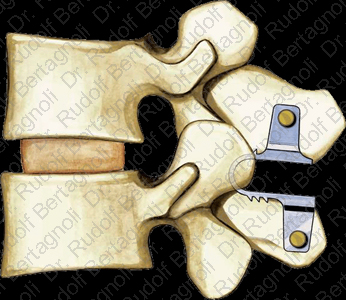Interlaminar Decompression
also known as Interspinous Process Decompression (IPD)
Interlaminar Decompression: Definition
Interspinous Process Decompression is the popular name for Interlaminar Decompression. It places an Interspinous Distraction Device (spacer) between the spinal processes of two adjacent vertebrae in order to reestablish the normal disc height between the two vertebrae. Some devices (Coflex) can additionally use large amounts of contact to the laminae and thus improve its effect and improve biomechanics. This procedure is distinct from the more invasive pedicle screw based dynamic spine stabilization, which uses screws to secure devices to the spine.
Interlaminar Decompression: Indications
- Lumbar Stenosis
- Degenerative Disc Disease
- Nerve Compression
- Hypertrophied Ligamentum Flavum
Interlaminar Decompression: Device Choice
Current Interlaminar Decompression Devices available in Europe are the:
- Coflex™ (formerly Intraspinous U)

- Bioflex System with Nitinol Implants
- DIAM™
- CoRoent
- ExtendSure
- Minns
- X STOP® (FDA approved)
- Wallis® (FDA trials)
*Dr. Bertagnoli does not necessarily recommend every device listed here.
Interlaminar Decompression: Surgery
Interspinous Process Decompression uses Interspinous Distraction Devices (spacers) to relieve nerve compression by reestablishing disc height in a minimally invasive manner, thus avoiding a fusion, an artificial disc replacement (ADR) surgery or the now destabilizing, controversial full laminectomy. In the Interspinous Process Decompression surgery the “spacer” is inserted posteriorly through a four to eight centimeter incision and permanently attached to the spinal processes of two adjacent vertebrae. Before implantation, microsurgical decompression of the spinal canal or nerve root outlets is done to free the compressed nerves.The surgeon must be very careful not to overdo this microsurgical decompression in an attempt to make additional space. For the implantation, itself no removal of any bone material is done, which preserves the joint in the event any further surgery is required. The supraspinous ligament is not removed in this procedure; therefore it continues to support the stability of the spine. The “spacers” support normal flexion and restrict painful motion.
Interlaminar Decompression: Surgery Risks
All surgery carries risks from anesthesia, blood clots and infections. If complications from these risks arise, they most often can be successfully treated. The physical condition of the patient (such as obesity and diabetes) can also add risk to surgery.
Interlaminar Decompression: Surgery Long-Term Outlook
The appropriate surgical procedure properly executed will provide long term relief for the degenerated conditions treated. However, if the condition was allowed to continue too long and the nerves have become damaged, there may be some remaining pain or numbness or no improvement problems in other areas of the spine may appear at a later time.
Interlaminar Decompression
